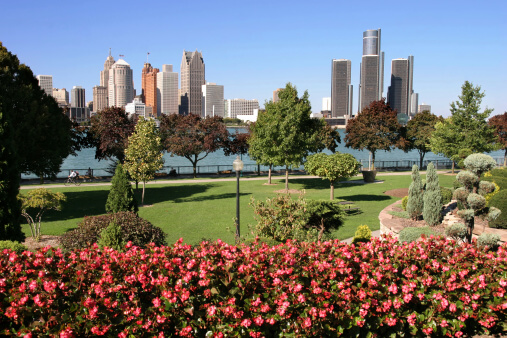
Best Lawn Grass for Detroit Area
With its northern location, there should be no surprise that Michigan is in the colder range of the USDA Climate Zones. Detroit’s proximity to the lake helps to give it slightly warmer winters than the rest of the state, but no one would call them warm. Couple that with a short summer, and any warm season grass you plant will end up being brown and dormant for 9-10 months out of the year.
Creeping Red Fescue
There are several varieties of fine fescues, including hard fescue and sheep fescue, but the dominant variety in Detroit lawns is creeping red fescue. Creeping red is a fine-bladed grass that has a medium to dark green color. It has a great tolerance for shade, and is often used on lawns that have heavy shade, or 2-4 hours of sun per day.
That shade tolerance is why you’ll often find creeping red in shade mixes, along with other cool season grasses. Newer varieties also have increased salt and insect tolerance, which helps add to the strength and durability of the lawn as a whole.
Perennial Ryegrass
This bright green grass grows quickly and expands well. The fine to medium grass blades may not look like much, but this grass is very tough. If the lawn does get damage, the fast growing speed helps to fill in the damaged areas quickly. That does mean that you might need to mow more often, but leaving the grass clippings on the lawn is a good source of nutrients.
You’ll often see ryegrass in lawn mixes, both in partial shade mixes and full sun mixes. A big reason for this is that fast growing time. Ryegrass is usually established in 7-14 days, long before the other grasses in the mix. That fast growing time helps to prevent erosion and fill in the lawn faster.
Kentucky Bluegrass
The vast majority of lawns around Detroit and throughout Michigan have Kentucky bluegrass. Depending on the variety, these can have a fine to medium texture with a color anywhere from bright green to a dark bluish green. It’s not as strong as other grasses, and works best in low to medium use areas like lawns.
Bluegrass takes a long time to get fully established, sometimes 1-2 months. This is a big reason why ryegrass is often added to the lawn mix. Once it does get established, it will create a thick, dense turf that’s beautiful and soft underfoot.